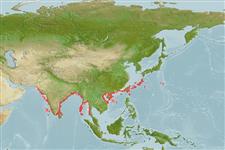sub class Elasmobranchii (ฉลามและกระเบน) (sharks and rays) >
Carcharhiniformes (Ground sharks) >
Carcharhinidae (Requiem sharks)
Etymology: Glyphis: Tautonymous with Carcharias glyphis Müller & Henle 1839 (See ETYFish); gangeticus: -icus (Gr.) belonging to: Ganges River, India, where Müller and Henle mistakenly thought it occurred (See ETYFish).
More on authors: Müller & Henle.
Environment: milieu / climate zone / depth range / distribution range
นิเวศวิทยา
เกี่ยวกับทะเล,น้ำเค็ม; น้ำจืด; กร่อย สัตว์น้ำหน้าดิน; สัตว์น้ำที่อพยพไปๆมาๆ ระหว่างแหล่งน้ำจืดกับทะเล ที่เป็นไปตามช่วงชีวิต (Ref. 51243). Tropical; 30°N - 8°N, 65°E - 143°E
Indo-West Pacific: north Indian Ocean, Indus River outside Karachi, Pakistan to Bangladesh, Myanmar, Thailand and Borneo.
ขนาด / น้ำหนัก / Age
Maturity: Lm ? range ? - ? cm
Max length : 204 cm TL เพศผู้/กระเทย; (Ref. 244)
Biology poorly known. But its minute eyes suggest that it may be adapted to turbid water with poor visibility, as in large tropical rivers and muddy estuaries. Newborn specimens are from 56 to 61 cm long. Viviparous (Ref. 50449). Its notoriety may have stemmed from its widespread confusion with C. leucas. But this species is potentially dangerous as well because of its size and large teeth, though its reputation as a man-eater is still unproven.
Life cycle and mating behavior
วัยเจริญพันธุ์ | การสืบพันธุ์ | การวางไข่ | เซลสืบพันธ์ของเพศเมีย(ไข่) | ความดกของไข่ | ตัวอ่อน
Viviparous, placental (Ref. 50449). Distinct pairing with embrace (Ref. 205).
Compagno, L.J.V., 1984. FAO Species Catalogue. Vol. 4. Sharks of the world. An annotated and illustrated catalogue of shark species known to date. Part 2 - Carcharhiniformes. FAO Fish. Synop. 125(4/2):251-655. Rome: FAO. (Ref. 244)
IUCN Red List Status (Ref. 130435: Version 2024-2)
Threat to humans
Traumatogenic
Human uses
การประมง: การประมงยังชีพ
เครื่องมือ
Special reports
Download XML
แหล่งที่มาจากอินเตอร์เน็ต
Estimates based on models
Preferred temperature (Ref.
123201): 24.6 - 28.1, mean 26.3 °C (based on 141 cells).
Phylogenetic diversity index (Ref.
82804): PD
50 = 0.5312 [Uniqueness, from 0.5 = low to 2.0 = high].
Bayesian length-weight: a=0.00490 (0.00229 - 0.01045), b=3.08 (2.91 - 3.25), in cm total length, based on LWR estimates for this (Sub)family-body shape (Ref.
93245).
ระดับชั้นอาหาร (Ref.
69278): 4.2 ±0.7 se; based on size and trophs of closest relatives
ความสามารถในการกลับคืนสู่ปกติ (Ref.
120179): ต่ำมาก, เวลาต่ำสุดที่จะทำให้ประชากรเพิ่มขึ้นเป็น 2 เท่าใช้เวลามากกว่า 14 ปี (Assuming Fec<10).
Fishing Vulnerability (Ref.
59153): Very high vulnerability (90 of 100).
